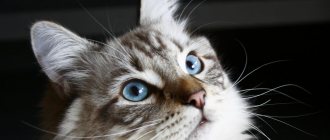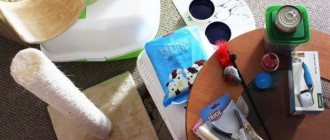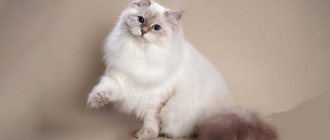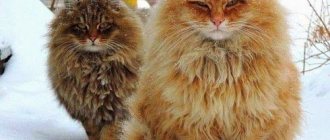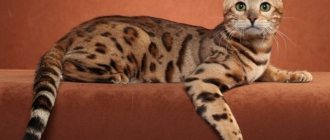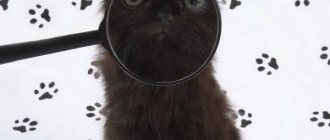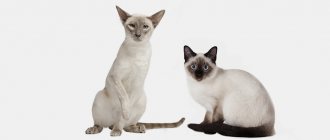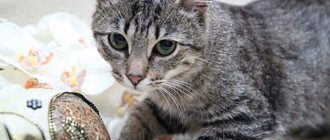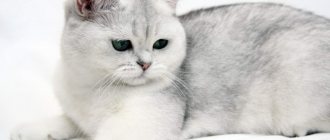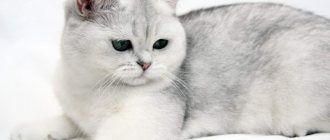The cat with the beautiful poetic name Neva Masquerade belongs to the Siberian subspecies of cats. Long hair, color point (Siamese coloring) combined with blue eyes created an amazing creature. If you add to this the masquerade, striped color of the face, then a masquerade cat will appear in front of you in all its glory.
History of the Neva Masquerade breed
It is not known for certain when and how the masquerade cat appeared. There are two hypotheses for the origin of the breed and scientists are still arguing about the likelihood of both. It is known for sure that the basis for its creation was the Siberian breed. According to the first hypothesis, the Neva breed originated as a result of mixing with the Siamese cat, according to the other - with the Persian color-point.
For the first time, Nevaks, as these beauties are also called, were presented to the public at an all-Union exhibition in 1988, held in Leningrad. Experts appreciated the beauty of the masquerade cat, identified them as a new breed and gave it a name after the venue of the event on Niva - it means “Neva”. The second part of the name – “masquerade” – appeared due to the color of the muzzle, which resembles a mask. International organizations recognized the Neva Masquerade cat breed relatively recently - in 2009.
Interesting facts about the breed
Siberian color dogs live with some Russian celebrities. Ballerina Anastasia Volochkova adores the nevaka Georges, and TV presenter Tatyana Pushkina is attached to the cat Stesha. The representative of the breed, the cat Dorofey, feels great with the Prime Minister of the Russian Federation D. Medvedev. Having received the title of “the first cat of the country,” he boldly entered into a duel with the furry pet of M. Gorbachev, who lived next door.
D. Medvedev presented one of the descendants of his Nevaks as a gift to Tarja Halonen, the former head of Finland. Russian President Vladimir Putin made a living gift to the governor of the Japanese prefecture, presenting him with a Siberian Color Point.
The fame of Siberian masquerade parties crossed the borders of Russia and reached Hollywood. Here the Nevaks also rose to the occasion: a cat named Blue-Eyed Angel starred in the film “Nine Lives.” In the TV show “Planet of Cats” the Neva Masquerade is also one of the heroines.
I would like to dwell on the advantages and disadvantages of the Neva Masquerade breed. Among the undeniable advantages it should be noted:
- grace and beautiful, elegant appearance;
- good adaptation to new conditions;
- friendly character traits;
- excellent health and long life expectancy.
Among the shortcomings in the arsenal of the Nevaks are signs of phlegmatism and a stubborn disposition. They require a lot of space and space to live. Fur coat care is an important part of keeping a furry pet. Otherwise the breed is cute and popular. Blue-eyed animals native to the Neva are devoted friends and the pride of their owners.
Description and breed standard
The Neva Masquerade cat has a breed description similar to the Siberian. We can say that the Neva cat is a special case of the Siberian breed, with a certain color.
However, the masquerade cat is a separate breed and has its own standards:
- Athletic build with strong bones and well-developed muscles.
- The head is large and heavy, trapezoidal in shape with a low forehead and without sharp visible transitions in profile.
- Short strong neck.
- The eyes are large and round, slightly slanted.
- The ears are medium in size, set wide apart, tilted forward, and have rounded tips. Tassel decorations are welcome.
- The body is of medium length, strong, with a wide chest. The body fits into a rectangle.
- The paws are large and long, with tufts of hair between the toes.
- The tail of this breed is wide and fluffy, with a rounded tip. Its length is approximately up to the shoulder blades.
- The Neva Masquerade has a semi-long, fluffy coat. The coat lengthens from the withers to the tail. The neck is decorated with a collar, and the hind legs are decorated with pants.
An adult cat weighs 8-9 kg, females are smaller and lighter. The life expectancy of the Neva Masquerade is on average 13-15 years. In some cases, with proper care, they can keep company for up to 20 years.
The Neva Masquerade is one of the few breeds that can be called hypoallergenic. The breed is unique in its minimal content of allergy-causing antigens. Contrary to the general belief about wool allergies, the human body does not tolerate wool, but the antigen found in saliva. When an animal licks itself, saliva containing the allergen remains on the fur.
History of the Neva Masquerade Cat.
Siberian cats are a part of Russia and ourselves. What Russian person has not heard about the existence of this, one of the most beautiful, cat breeds! Our heritage and our pride, which foreigners were able to appreciate. Neva Masquerade cats are very popular outside of Russia and are very expensive there, and at exhibitions the Siberian Color Point shines along with other representatives of other breeds, often not inferior to the American Maine Coons, of which the Americans are so proud, and the Norwegian Forest cats, the pride of the Norwegians.
The name “Neva Masquerade” is associated with something elegant, festive and at the same time native, not overseas. A bright, extravagant name, coupled with an unusual and even chic appearance, attracted the attention of the felinological community, and this immediately distinguished them from all Siberian cats, distinguished by their diversity in colors. The attention was followed by enthusiastic responses from the judging, leading to Best in Show victories.
There are no legends associated with the origin of the Nevaks, of which there are many among the Siamese or Burmese. Nevertheless, the Siberian cat itself has already become a legendary breed.
The selection of Neva Mascara cats began at the Kotofey club under the leadership of Olga Mironova. All this happened in the city of St. Petersburg, which is why the breed is named after the river on which the city is located. Of course, the breed is officially called “Siberian Color Point”, and “Neva Masquerade” is a common name. Nevertheless, the fact that it has taken root and is universally loved suggests that it was very well chosen. Neva Masquerade Dogs, or Nevaks, have been recognized and bred since 1989. At exhibitions, these animals always attract many visitors who admire these big beauties.
The Siberian cat is an aboriginal breed, i.e. a natural breed, not artificially bred, but formed under the influence of nature itself, in accordance with the living conditions of the animal. A breed of semi-long-haired cats that formed in the Urals and Siberia and was known during the time of Peter I. It is believed that the gene for long hair was acquired from Angora cats back in the days of the Mongol Empire.
In its history, the Neva Masquerade, like the Siberian one, keeps many mysteries. It still remains a mystery where Siberian cats acquired the color gene. It is believed that the breed is based on matings of Siberian and traditional Siamese or Himalayan cats. But it is also possible that this is a manifestation of hereditary recessive albinism. This is just speculation. One thing is clear - Neva masquerade cats are a mixture of the power of Siberian cats and the exoticism of the Siamese cat! There is no doubt about this.
So, work on breeding Siberian Colorpoints began in St. Petersburg and continued in Moscow. It was here that the breeding of this breed received its further development. For a very long time, nurseries in St. Petersburg and Moscow preferred to work independently of each other. Now you can already meet animals where the lines of St. Petersburg and Moscow nurseries intersect. But they are quite rare to this day.
Neva Masquerade cats are the least allergenic: a recent chemical analysis of saliva showed that Siberians lack the protein that most often causes allergies. They are undoubtedly able to brighten up loneliness.
Natural beauty, health, and ease of maintenance have made this cat popular and beloved among the population. “A cat worthy of decorating the Queen’s reception” is how the prim English speak of our Siberian cat.
So who is she and what kind of Neva masquerade cat is she?
First of all, this is a magnificent, very beautiful breed that attracts more and more attention and arouses genuine interest. Its representatives have good health and are physically hardy, they are brave and loyal and seem to be the personification of the Russian person. They conquer everyone with their power, grace, devotion to people and extraordinary intelligence. They are affectionate, sociable animals and good friends for children. Nevaks get along well with children and can forgive a child a lot without scratching or biting them.
On top of everything else, this is a completely fearless hunter, who by nature has a body with developed muscles and strong paws. His assets are a huge fluffy tail and blue eyes. They are the ones who win the hearts of all lovers of this particular breed! The image is completed by a long mustache, a fluffy “collar” and “pants” on the hind legs.
The Neva Masquerade is a large, affectionate domestic cat that can at any time protect its owner, create coziness and comfort in the house, and, by relieving fatigue and tension, heal a number of diseases.
They are ready for contact at any time and are always close to their owner. Nevaks love it when people communicate with them on equal terms and appreciate their extraordinary intelligence. These cats are partners by definition. They have self-esteem. They are never intrusive, but they love to talk with the owner and talk about their affairs. At the same time, they are extremely attentive and understanding listeners. An excited or upset owner can easily be calmed and comforted with melodious purring and quiet cooing.
Quite correctly assessing their size and weight (and this is a very large animal, by cat standards, reaching 8-10 kg in weight; cats are much smaller and more graceful than cats and their character is softer and more flexible), they will not hang on the curtains or jump high on the closet, but at the same time they easily show very complex acrobatic sketches on the floor and sofa.
You can admire these cats incessantly, without finding the strength to take your eyes off them! And no one has ever been able to restrain an exclamation of admiration after seeing a real Neva Masquerade Cat! Nevaks are not picky. They take care of themselves very well. These cats do not require special care; it is enough to brush them during seasonal shedding, which happens 2 times a year, and periodically clean their ears. Their fur does not form tangles. Thanks to their high adaptability to various, including warm, climates, Neva masquerade cats, like Siberians of traditional colors, have learned to “undress”, i.e. in warmer and even hot climates, they shed “extra” hair, in a word, they exchange their beautiful fur coat for a lightweight coat, while leaving a chic fluffy tail...
Having received good immunity from their “parents” - Siberians, Neva Masquerade Dogs easily adapt, easily tolerate moving and do not require frequent visits to the veterinarian from their owners.
The owners of Neva Masquerade cats never have problems with “bad behavior”. Good manners are “in their blood” and are fixed at the genetic level.
Neva Masquerade cats get along very easily with other pets, including any breed of dog, because... They are distinguished by high sociability and curiosity.
| Colors of Nevaks |
| The Neva Masquerade cat differs from the Siberian only in its color. Color-point, or more simply, Siamese, is a very elegant color, and bright blue eyes have become a true decoration of the Siberian breed. Among the Neva Masquerade Dogs, the most common colors are seal tabby point (the mask, paws and tail are dark brown striped, and the rest of the coat is ivory), and slightly less common are seal point (the mask, paws, ears and tail are solid brown). . There are also variations of blue tabby point and blue point (the same thing, only in gray, the rest of the coat has a cool ivory shade). More rare are the red tabby point and red point colors (the coat is usually white and the markings are red). Blue tabby point and silver cats look very elegant. They are the least common. All these colors also have colors with white or bicolors, i.e. with various white spots on the paws and face. The animal's tail may also be white. |
Seal Point
This is the most characteristic color for cats of the Neva Masquerade breed. Its distinctive feature is that its muzzle, ears, tail and paws are black and brown. The color of the body itself can be almost white, or it can have an almost brown tint; the most common are light gray and cream body colors. But regardless of the shade of the color of the body, the contrast with the color of the limbs and the “mask” must be visible. If the body is very dark, the muzzle should still be darker.
Seal tabby point
This color complements the seal point stripes on the paws and muzzle. There are no other differences or requirements for this color. In general, all color-point breeds, and the Neva Masquerade is no exception, change color to a darker color with age. But this, of course, does not make them any less beautiful.
Nevaks with a white body look very impressive; the judges give their preference to them. But, unfortunately, this color lasts in animals until a certain age. And the more rigid the cat’s guard hair (and this is a very desirable trait for Siberians), the earlier the darkening process begins. But the dark color of the guard hairs highlights the light color of the undercoat.
The animal's undercoat is made up of softer, finer hairs that remain light throughout its life. This is why during molting, Nevaks become darker, because. At this time they lose all their undercoat, and begin to lighten when they are overgrown with it again.
Blue Point
Blue Point cats are distinguished from Seal Point cats by their lighter points, with a gray-blue tint. It is advisable for Blue Points to have a lighter body, because... if the animal has a more saturated dark color, then the contrast of the body and points will become almost invisible.
Cats of these colors should have deep blue eyes. Because If the cat's eyes are light, then against the background of the bluish tint of the fur coat they will look faded.
Blue Tabby Point
Just like the seal tabby point, the blue tabby point color only complements the blue point color with stripes on the paws and face. Animals' eyes should also be brighter - blue. There are no other differences or requirements for this color.
Red point and red tabby point
T
If you are the owner of a cat of this particular color, you can consider yourself lucky - this is a very rare color among Neva masquerade cats. Their points are red in color, their body is almost always pure white or slightly golden. Against the background of the red muzzle, the eyes appear even bluer.
Accordingly, red tabby point is a color with stripes on the paws and face.
Torty point
Torty Point is a color that is popular among breeders. It is characterized by a combination of red and black spots that form bizarre patterns on the fur.
Animals of this color, like all color points, should have darker muzzles, ears, limbs and tails. To find red spots on the ears and heels of a small kitten, you need to try hard. This is what creates difficulties in determining color. Such spots constantly grow and change shape with age. Therefore, it is impossible to predict what the appearance of a tortoiseshell kitten will be in a year. But on the other hand, there are no two completely identical tortoiseshell cats in the world - each has its own special features. Moreover, only cats can be tortoiseshells.
Silver Point
Work on breeding cats of this color began quite recently, so it is still quite rare. There are the following variants of this color: seal-silver-point, blue-silver-point and red-silver-point, as well as all variants of these colors with tabby and white.
It should be noted that the red-silver-tabby-point color still exists only in theory.
The color is so named because the cat's fur appears to be covered with a silver coating. This occurs due to the coloring of the upper part of the hair. And the lower part of the hair remains white. The coat of such animals can be compared to the color of chinchillas or arctic foxes.
Color point with white
The Siberian breed standard allows any amount of white and a combination of white spotting with any base color. Animals may have small white spots, for example, on the chest, or may be the classic bicolor with white on the face, white chest, belly and legs. Moreover, there are no standards regarding the location and shape of these areas.
| Standards of the Neva Masquerade cat in various systems The Neva Masquerade cat in different felinological systems is considered as a variation of the color of Siberian cats (WCF, TICA), and is also considered an independent breed with its own standard, different from the standard of Siberian cats of traditional color (FIFe, ICU, MFA) Unfortunately, not all international felinological organizations recognize the color-point variation of the color of Siberian cats, in contrast to the classic colors of Siberians. This, however, does not prevent true connoisseurs of Neva Masquerade Dogs from loving them and continuing to engage in targeted breeding with the hope of early recognition of the color by all international associations and federations... So, let's look at the breed standard in various systems WCF system standard BREED Siberian GENERAL CHARACTERISTICS Strong, massive, muscular cats of medium to large size. Cats are much smaller than cats. HEAD In the shape of a short, wide trapezoid in good proportion to the body, massive. The forehead is wide, slightly rounded. A smooth transition from a low forehead to a wide, straight bridge of the nose. The nose is of medium length, wide, a small depression is visible in profile, but without a stop. The cheekbones are low, the cheeks are full, the jaws are well developed. The chin is wide, fairly strong, but not protruding. NECK The neck is short but very strong. EARS Medium size, wide at the base, spaced at a distance of more than the width of one ear at the base. The outer line of the ear is vertical, the outer edge of the base of the ear is located slightly above eye level. The ears are slightly tilted forward. The ends are rounded. Brushes and brushes are desirable. EYES Large, round, set wide and slightly oblique. Eye color is blue, rich, evenly colored. The distance between the eyes is quite large. BODY Strong bones with well-developed muscles; dense, massive, medium length. The limbs are of medium height, strong, forming a rectangle with the body. Powerful neck, wide chest; the body is proportional to create a rectangular outline. The paws are large, round, with tufts of hair between the toes. TAIL Wide and strong at the base, length almost to the shoulder blades, well furred. The tip is rounded. WOOL Semi-long; The outer hair is hard, shiny, water-repellent, lengthening from the shoulder blades to the croup, descending to the sides and upper part of the tail. On the sides the coat is softer, loosely fitting, and very dense. The undercoat is double, depending on the season: a slight short, close-fitting one in warm weather, in winter it is a profuse long one, very thick and dense, with an excellent texture. The decorative coat is long but dense, in the form of a mane, full collar and frill. Lush “pants” and a perfectly bushy tail. Short hair on the shoulder blades. During seasonal molting, almost nothing remains of the decorating fur. TYPE Strong, massive. COLOURS Neva masquerade cats have the following color variations: Seal-point, Blue-point, Red-point, Tortie-point, and all these types of tabby colors (Tabby) and all colors with white (... with white or bicolour). Not long ago, a silver shade was introduced for these point variations (...silver). Today all colors are recognized, except for the chocolate-lilac color variants. All colors are allowed, with the exception of chocolate, lilac, cinnamon and fawn, as well as Abyssinian ticking. For Neva Masquerade cats, any harmonious combination with white is acceptable. CONDITION Healthy, strong, strong, well-groomed cat. DISADVANTAGES Small overall size; straight profile; compliance with the “Persian” type; long, light, narrow muzzle; flat cheeks; weak cheekbones; weak chin. Small; round; deep-set eyes. Large or narrow set ears, straight or high set, "Persian" type (small, low set, excessively pubescent). Limbs are too long or too thin. Short body, graceful type, weak bones, small paws. No tufts of hair between the toes. Slender long neck. The tail is short, poorly furred, with a sharp tip. The coat is without undercoat, hard, ragged, not shiny on the back and rump. Overgrown undercoat of the “Persian” type. CROSSING WITH OTHER BREEDS IS NOT ALLOWED. POINTS SCALE: Head - 20 Ears - 5 Eyes - 5 Type - 25 Limbs - 10 Tail - 10 Fur - 20 Condition - 5 TOTAL - 100 Nursery Frossika |
Website: feliscats.ucoz.ru
Breeder: Nadezhda Khokhlova
Phone:+7 e-mail: [email protected]
Feeding recommendations:
For kittens from 5 weeks to one year old, the following kitten food is recommended:
— Junior >>>After a year, food for adult cats: — Adult Alpine Beef >>> — Adult Atlantic Salmon >>> — Adult Pastured Lamb >>> If your pet is over 10 years old: — Best Age 10+ >>>In addition It is recommended to use dry food and wet food.>>>
Colors of the Neva Masquerade cat
Color-point color means a light body and dark ears, paws, tail and muzzle.
The breed allows several color options for Neva Masquerade cats:
- Seal point – characterized by dark markings on a light background:
- Seal tabby point - distinguished by a striped pattern on an ivory background:
- Red Point – has red markings and is considered a rare variant:
- Blue point – shades of wool are cold, one might say “blue”:
- Tortoiseshell color - combines three colors, females predominantly have this color:
In the Neva Masquerade cat, chocolate-lilac and Persian colors are not allowed by the current breed standard. The absence of undercoat is also not allowed.
Interestingly, all kittens are born white - a color feature of the breed. The gene responsible for color that is not sensitive to high temperatures. The pigment will not color the hair until the ambient temperature becomes cooler. The muzzle, ears, paws and tail are colored because they are the coldest parts of the body.
Neva Masquerade kitten, 2 weeks old
Types of drawings
Felinologists (specialists in the breeding and selection of cats) distinguish 4 basic types of patterns inherent in the tabby color:
- ticked (Abyssinian);
- striped (mackerel);
- classic (marble);
- spotted (leopard).
Ticked
The most inconspicuous, barely distinguishable tabby color is ticked.
The color of the coat of such a pet is almost monochromatic. But, if you look closely, you may notice slightly visible stripes, small marks or small “freckles” that differ from the dominant background of the cat’s fur by a couple of tones. A pronounced, clear pattern is observed on the muzzle, chest, paws and tail of the animal.
The ticked color option is typical for Abyssinian cats. Hence the second name for this tabby color – Abyssinian.
Striped
If there are expressive narrow lines on the cat’s fur, then the color is considered striped, brindle (due to its resemblance to a tiger).
Vertical stripes are distributed parallel to each other, starting from the spine and going down to the stomach in many branches. The stripes stand out against the main background in a contrasting color.
Another name - mackerel - the pattern received due to its similarity with the coloring of mackerel - a striped fish.
Classical
The classic tabby color is considered the most beautiful.
The graphic patterns on the paws and neck of the animal are not very clearly expressed. The back and sides of the cat are decorated with interesting large spots, various curls and wide stripes.
Thanks to the contrasting color, intricate figures stand out well against the dominant tone ─ any tone other than white. This color is also known as “marble”.
Spotted
The spotted color type is defined by felinologists as leopard print. It is characterized by patterns that consist of specks and specks. A drawing of a relatively dominant color may be bright or not very different in tone from the base. An animal with this pattern looks like a small leopard.
Rarer variants
There are cats with rare tabby colors. Such colorings are an exception and do not fit into the main classification of tabby types:
- rosette: reminiscent of leopard print. Large spots with a dark outline look like irregular circles with a light center. The colors of the pattern contrast with the main background of the wool;
- tortoiseshell: characterized by the presence of two colors in the color of the animal (mainly yellow and black shades). The spots are very bright, arranged in a chaotic manner;
- Calico: another basic tone is added - white. The pattern consists of short stripes and spots located on the pet’s paws, neck, muzzle and tail. The Calico tabby color is also called "spotted and white";
- patched: unusual coloring combines tortoiseshell and calico. A fairly large pattern of spots of different colors resembles patches;
- Links point: the pattern covers only some parts of the body (ears, muzzle, limbs, tail, chest or spine area). The body of a pet with a lynx point color is one color.
Tabby calico kitten
Photo of the Neva cat
Character of the Neva cat
Neva Masquerade cats are very smart and intelligent. Siberian Color Points quickly learn to use a tray and scratching post. Representatives of the Neva breed are loving towards their family, but they single out one person to whom they become more attached than others. The cat is always ready to accompany the owner and is very sad in the event of a long separation. The Neva Masquerade is careful with strangers and will not tolerate familiarity in communicating with itself.
For a comfortable life in the house and understanding their place in it, Neva cats need to establish clear rules. Therefore, from the first days a kitten appears in the house, explain to it the norms of behavior. Stick to the rules laid down at the beginning of your life together, and order will reign in the house.
History of origin
First, let's talk about the Siberian cat itself - what it is, where it came from, and what typical features are characteristic of it.
The Siberian cat is believed to originate from Russia. The first mention of it can be found in manuscripts of the sixteenth century. In those days, this variety was called Bukhara, and its distribution area was in the countries of Central Asia.
The cat was probably brought to Siberia by nomads and traders, who bred these animals to protect their goods from small rodents. In those days, this was relevant not only because mice and rats spoiled seasonings and cereals, but also because they carried the plague and other dangerous diseases. Therefore, the cat was simply necessary.
In the territory of Siberia and Transbaikalia, the characteristic features of this breed arose and were formed - wide bones, dense physique and thick fur with a dense double undercoat, which protected the cats from the cold.
Siberians are famous for their wide palette of colors. Among them you can find black, brindle, red, marbled, tabby, dame, tabby, and tortoiseshell cats. And even a chinchilla!
These murkas have a rich hunting past. The genetic memory of him leaves an imprint on their character and character traits. However, do not be afraid - these cats are non-aggressive. But they are inquisitive, attentive, love to play, climb into secluded places and watch their toy “prey” from above.
Care and maintenance
Caring for Neva masquerade beauties is quite simple. The main thing is to completely comb your pet once a week, leaving only the tail untouched. The tail fur is fragile and can be easily pulled out without any effort. If you brush your tail, the hair will take a long time to grow back. During the molting season, carry out the procedure 2 times a week. For regular care of the coat and undercoat, you will need a slicker brush and a massage comb.
A masquerade cat should be bathed once every 2-3 weeks or as needed. Nevaks do not like to take water procedures, but they tolerate it. For bathing, it is recommended to use a special shampoo for long-haired breeds.
Otherwise, stick to the general basics of caring for your cat.
Training and education
An obligatory part of the development of a little Thai is training. It helps satisfy the animal's intellectual needs. Kittens are easy to train to use a scratching post. Do not allow children to climb on tables.
Important! It is very difficult to wean an adult cat from bad habits.
When training cats, use only positive emotions. First, establish a trusting relationship with your pet. Study all his preferences. It is much easier to teach a cat to do what he likes on command.
If you don't have enough time and patience to train, don't start them. After some time, the cat will begin to understand you and perform appropriate actions even without training.
Nutrition
Although the Neva breed is known for its excellent health, it is still worth taking care of their high-quality nutrition, which will take into account all the needs of the pet. Otherwise, you can irreversibly damage the health and appearance of strong and elegant animals. The best choice is high-quality dry and wet food, which contains everything necessary for the beauty and health of a masquerade cat.
Natural feeding is much more complex and has many limitations. In this option, the diet should consist of dietary meat (excluding pork) and offal. It is recommended to freeze or scald meat and offal beforehand. Vegetables are definitely added to the menu. You should limit the amount of seafood, including fish and liver. The last listed products in the diet of a masquerade cat can significantly spoil its color.
You should never feed a Neva cat from the table: salt, sugar, smoked, fried, and fatty foods will not benefit the cat’s body.
Neva cats do not have a tendency to obesity, but it is worth sticking to the feeding schedule - twice a day. Kittens need more food than adults. The daily food intake for kittens should be divided into 5 feedings, gradually reducing the amount to 2 servings.
What to feed a Thai cat
Many owners make the grave mistake of giving their pets the same food that they feed themselves. Most purebred animals can only eat specialized food from well-known brands:
- Dry food. You should not constantly keep your Thai pet on such a diet: it will cause dehydration and kidney problems in the kitten.
- Raw meat, vegetables. The breed readily eats natural products. They need to be preheated to 20-25 degrees and monitor the expiration date. You can give any meat, but liver and low-fat kefir are not recommended. You cannot feed the animal fish.
- Treats. To pamper your Thai pet, treat him with ready-made canned food from certified manufacturers, lightly salted fish, and fatty processed cheese no more than once a month.
Health and illness
The breed was bred in nature through natural selection and is famous for its excellent health. The Neva masquerade cat has virtually no hereditary diseases.
The only thing owners may encounter is hypertrophic cardiomyopathy. Heart pathology, if not diagnosed and treated in a timely manner, leads to heart failure. In the most advanced cases it can be fatal. The disease does not have pronounced symptoms, so it is better to immediately examine the cat by a specialist. The earlier the disease is detected, the longer the pet’s life will be and the lower the risk of developing unpleasant consequences.
Similarities and differences with the Siamese cat
As we have already noted, both Siamese and Thais descended from the Old Siamese cat. They have a lively temperament, are playful, and love to “poke their nose” into all the affairs of their owners. They also have an external resemblance - a light fur coat with dark markings, blue eyes. However, if you look closely at the photographs of these two breeds, the differences will become obvious, and you will no longer confuse them with each other. It's all about the different body structure of these cats.
Siamese cats are characterized by thinness, an elongated body, an elongated tail, their head resembles a wedge in shape, and the forehead and nose are almost a single feature, that is, as such, the bridge of the nose does not appear on their face. The Thais have a clearly visible depression in the area of the bridge of their nose. Their eyes are also more elongated than those of the Thais. The ears of Siamese are so large that they seem disproportionate to the head, while in Thai they are of medium size, their tips are slightly rounded.
Choice and cost of a kitten
When deciding to get a Neva cat, you should think in advance: will it participate in exhibitions and breeding or is it just a pet. To select a kitten, it is recommended to contact experienced breeders and felinologists. They will help you choose a masquerade pet for specific purposes. The Neva breed is very difficult to choose based on color, since it is almost impossible to say exactly what an adult masquerade cat will be like. Masquerade kittens are born almost white, and the color is determined by a heat-sensitive gene.
Choosing a Neva Masquerade cat for participation in exhibitions or for breeding is also quite a difficult task. The reason lies in the fact that an adult Siberian completes its final formation only by the age of 2-3 years. The exhibition champion will have to be trained to show himself at the exhibition and accustomed to examinations by experts and constant travel. The price of a Neva Masquerade cat starts from $300 (from 20,000 rubles) for pets and is multiplied by two if these are breed or show class kittens.
It is recommended to pick up the chosen kitten from the breeder at 3-4 months, after the first vaccinations. First of all, make sure your pet is healthy: its activity, clean ears, eyes and butt will tell you about this. The pedigree of the parents will help ensure the purebred and good health.
Breeding
In the Neva cat, puberty occurs already at 6 months, but experienced breeders recommend mating at the age of one or one and a half years, since early pregnancy has a high mortality rate for the offspring. For crossing, it is better to use a purebred Neva Masquerade cat with experience, taken from a nursery.
The duration of pregnancy is 9 weeks. The cat is an excellent mother, so the care of the offspring can be completely entrusted to her. Many nurseries specialize in breeding the Neva Masquerade breed.
How to choose a kitten
Kittens are purchased when they are 3 months old. When purchasing a Nevak from a nursery, check the accompanying document: veterinary passport, birth certificate, pedigree. The veterinary passport specifies vaccinations and the timing of deworming (when the kitten received an anthelmintic drug).
When choosing a kitten, play with it. Pay attention to the condition of the coat and activity. The Neva kitten should not run wild or be afraid of sharp sounds (this is a sign that it was kept in a cage). Keep an eye on your mother, because hereditary traits are passed on from her.
Neva masquerade kitten photo
Neva kittens photo
Neva masquerade kitten photo
Neva masquerade kitten photo
Neva kittens photo
Neva cat nurseries
The breed has rightfully won attention all over the world and has found its fans. There are many nurseries in Russia and abroad offering Neva Masquerade cat kittens for sale.
In Moscow:
- atlasgrand.ru
- sibcat-rd.ru
- neva-cat.ru
- pitomnik-elita.ru
In Troitsk:
- vizantiyskypodarok.jimdo.com
In St. Petersburg:
- neva-cats.com
- kiskaneva.narod.ru
- sberegovnevy.ru
- sib-chudo.ru
In Kyiv:
- siberiansapphire.com
In Minsk:
- nevak.by
Reviews from Neva cat owners
Galina Our Neva beauty has an excellent character: moderately playful, moderately willful. I quickly got used to the new home. There are no problems with food and toilet. They get along well with the dog.
Alla Our Neva cat Boris chose his husband as his favorite. That's why we also got a masquerade cat, Marquise. We are very pleased with the character of our fluffies. Calm and mannered pets. When they were still kittens, they were taught the rules in the house, and since then we haven’t seen any pranks, except for small ones.
Angela They took an adult nevak at the age of 2 years. In life, the cat exceeded all expectations. This is due to the fact that we have a fairly active daughter and we were worried about what the reaction of an adult cat would be. We can say that the masquerade pet quickly found a common language with us, and especially with our daughter. They can play together, but when the cat gets tired of it, he calmly goes into another room. We are very pleased with the Neva breed, or maybe this is the merit of the previous owners.
Breed cost
Any nursery in a large city (not only in Moscow or St. Petersburg) will offer to buy a Neva kitten. You can buy a baby from a private owner or from a cat club. The price for a pet-class animal is within 12,000 rubles . Such kittens are not intended for breeding. A breed-class masquerade kitten will cost about 30,000 rubles . It has good reproductive characteristics and is capable of producing purebred offspring.
There are also show-class kittens, which, in addition to being purebred, represent an exhibition option. Their price is 35,000 rubles . The price is the same for a tortoiseshell-colored Nevak. The price for a cat is usually higher than for a cat.
For your information! Purchasing a purebred animal is not an easy matter. It is important to choose a nursery and carefully study reviews about it. A specific breeder must have recommendations and documents for a Neva kitten. There is no need to buy a purebred animal from strangers, relying on their honesty and decency.

